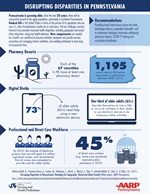Disrupting Disparities in Pennsylvania: Retooling for Geographic, Racial and Ethnic Growth
April 5, 2021
AARP Drexel Now
Rose Ann DiMaria-Ghalili, PhD, professor, associate dean for Interprofessional Research and Development and principal investigator of Cell2Society Aging Research Network, and Laura N. Gitlin, PhD, FGSA, FAAN, dean and executive director of the AgeWell Collaboratory, have partnered with AARP-PA to examine health disparities in Pennsylvania and produce the first report for the state along with actionable recommendations for Disrupting Disparities for older Pennsylvanians. This report, part of AARP’s Disrupting Aging series, draws upon interviews with key stakeholders state-wide, a comprehensive literature review, and analyses of databases on the health of Pennsylvanians to reveal alarming facts.
 Pennsylvania is growing older and very quickly with 40 percent of its 12,801,989 residents older than 50, and 18.7 percent over the age of 65. The Commonwealth faces extreme health disparities; older white adults living in rural and low resourced areas, and older Black/African American and LatinX adults living primarily in urban areas lack access to health care and culturally appropriate, evidence-based health promoting and chronic disease management practices. COVID-19 has exacerbated deep-seated disparities evident throughout Pennsylvania’s 67 counties and has revealed and furthered a digital divide. Closures of community-based services and programs compound lack of access to technology and telehealth solutions for these populations. Finally, lack of health care providers in various regions of the state as well as health professionals and direct care workers who are adequately trained and supported to deliver culturally appropriate and tailored care is a growing significant public health crisis.
Pennsylvania is growing older and very quickly with 40 percent of its 12,801,989 residents older than 50, and 18.7 percent over the age of 65. The Commonwealth faces extreme health disparities; older white adults living in rural and low resourced areas, and older Black/African American and LatinX adults living primarily in urban areas lack access to health care and culturally appropriate, evidence-based health promoting and chronic disease management practices. COVID-19 has exacerbated deep-seated disparities evident throughout Pennsylvania’s 67 counties and has revealed and furthered a digital divide. Closures of community-based services and programs compound lack of access to technology and telehealth solutions for these populations. Finally, lack of health care providers in various regions of the state as well as health professionals and direct care workers who are adequately trained and supported to deliver culturally appropriate and tailored care is a growing significant public health crisis.

The report further shows that one solution will not fit all and that there is no one “magic bullet.” Rather, a multi-prong approach targeting multiple risks and structural determinants will be necessary as well as tailored to regional variations is an imperative. An understanding of county-by-county differences in the aging experience is needed to guide targeted policies and practices that address differential unmet needs. DiMaria-Ghalili, Gitlin and their collaborators propose five actionable recommendations to disrupt aging disparities for Pennsylvania residents that can enable individuals 50 years of age and older to live long and purposeful lives.
The report, generated by an investigative team of the AgeWell Collaboratory seeks to innovate, educate and implement evidence-based solutions to enable individuals, families and communities to address the challenges and opportunities of a rapidly aging society.
-Written Roberta S. Perry